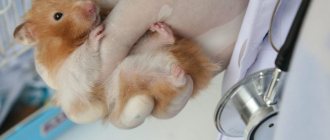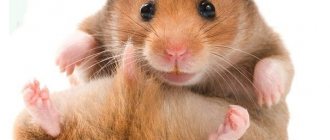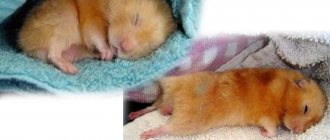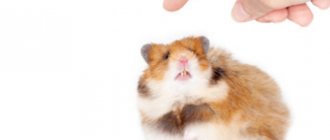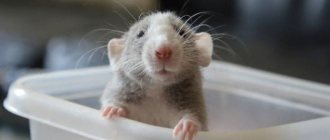- Pneumonia
Everyone knows that individuals from the hamster family do not live very long. However, babies tend to hibernate, and therefore, if the hamster does not move and is breathing heavily, it is worth making the first inspection yourself. Usually the first signs of the disease appear almost immediately and are noticeable even to an inexperienced breeder. If the pet lies on its back, squeaks, and after trying to turn it onto its stomach, jumps up and runs to the opposite corner of the cage, most likely it simply fell and could not turn over on its own.
Metabolic disorders
Metabolism is the proper functioning of all body systems. Food processing, energy production, removal of unnecessary and harmful products. The central nervous system is responsible for all this, but the glands that secrete hormones have a huge influence on metabolic processes. These include the thyroid and pancreas, adrenal glands, pituitary gland, and gonads. Poor nutrition, poor environment, and hereditary factors affect the functioning of these organs. Violation of their normal functioning leads to a malfunction of the body as a whole. Diseases of Djungarian hamsters are often associated with metabolic disorders.
Treating limb injuries at home
Is there a veterinary clinic in the locality where you live? Then don’t hesitate and take your pet there - qualified assistance is provided to you and the rodent. What should you do if a hamster breaks its leg, and there is not even a veterinarian in your locality or there is no way to contact one now?
First
and your most important action is to limit the animal’s movement. Any movement of the damaged paw is accompanied by severe pain.
In case of an open fracture, the wounded limb should be treated, that is, disinfected, and a plaster cast should be applied.
Second
– instead of bedding, use pieces of paper napkins so that the rodent does not dig into the bedding with its damaged paw.
Read also: What is a PCR test for coronavirus
Third
– Provide your pet with proper nutrition. It should contain quite a lot of calcium and protein, that is, in addition to the grain mixture, introduce the following products into the rodent’s diet:
- low-fat kefir;
- the fat content of cottage cheese and yogurt should be no more than 1%;
- white and yolk from one;
- (lettuce leaves).
Fourth
After the first three days of treating an injured hamster, you will be able to observe the dynamics of the therapy. Recovery of the limb will not occur if the rodent's paw begins to dry out or turn black. Here, contacting a specialist is inevitable. Sometimes the animals themselves amputate their limbs by simply gnawing off their paws. This outcome is quite depressing, but do not fall into despair. Hamsters are animals that can live a full life (100%), having 3 legs. Most often, hamsters' limbs do not die - the bones on the paws of rodents grow together perfectly. Try to be very attentive to your small pets. And then you won’t have to go to a veterinary clinic to get qualified help.
Reading time: 7 minutes. Published 04/09/2019
Fungal infections
What do hamsters suffer from, what mycoses?
- Dermatophytosis. The skin peels off, ulcers appear, and the fur begins to come out. Dermatophytosis must be treated with special solutions (chlorhexidine, miramistin), ointments or shampoos, which must be prescribed by a veterinarian.
- Lichen. In areas that have lost hair, fresh wounds and drying crusts are visible. The disease is contagious, so do not keep a healthy hamster in the same cage as a sick one. The sore is diagnosed by scraping and treated with special creams and ointments. If the hamster has no wounds or peeling on the skin, but the hair has fallen out, then this is not lichen, but vitamin deficiency.
Hypothermia or overheating
Both of these factors seriously undermine the pet's health. The fact is that hamsters themselves love warmth, so drafts have a detrimental effect on their health. But at the same time, in nature they live in dark burrows, so direct sunlight or stuffy space also undermines the health of the animal, even to the point of death. This can be very unexpected for the owner and he will never be able to understand why the hamster died. Ideally, the room where the cage is located is +20-22 degrees.
How hamsters die and what sensations they experience before death, we, the owners, cannot understand. But we can organize proper care for the animal and thereby prolong its life.
What to do if your hamster doesn't move? What could be the reasons? Hamsters can hibernate and during hibernation their heart rate and breathing rate drop. Sometimes it is even difficult to tell whether the hamster is sleeping, or whether the reason is different. If you find that your hamster is not moving, here is what to do.
Baldness
Baldness (alopecia) is a consequence of vitamin deficiency. Often occurs in winter due to prolonged feeding of dry food. In this case, no medical procedures are necessary. Baldness goes away quickly when the animal begins to eat green food. Therefore, caring owners should prepare green complementary foods for the winter and store them in the freezer.
Hamsters go bald for various reasons. The most likely is a lack of vitamins.
Sometimes owners are concerned about dark spots on the sides of the hamster's skin. But this is not a disease. The lateral glands are sometimes marked with excessive pigmentation, and this does not affect the health of the pet.
Symptoms of diseases
How can you tell if your hamster is sick? This question interests many breeders of small pets. A healthy hamster has beautiful shiny fur, leads an active lifestyle, especially at night, and shows interest in the world around it. The animal eats food with appetite, makes supplies, and arranges its home. The Djungarian, the Syrian, has clear, clean eyes and an expressive gaze.
Important! You can understand that a rodent is sick not only by external signs, but also by the changed behavior of the hamster.
Main symptoms of diseases:
- decreased activity, lethargy, apathy;
- deterioration of fur condition (wet fur);
- severe itching;
- the appearance of scratches, bald patches, wounds, ulcers on the body;
- discharge from the nose, eyes;
- increased thirst;
- allergies, skin rash;
- bowel dysfunction (diarrhea, constipation);
- frequent urination;
- pallor, cyanosis of mucous membranes;
- sticky eyelids;
- the presence of blood and clots in the urine;
- disturbance of breathing, heart rhythm;
- accumulation of wax and dirt in the ears;
- yellowness, peeling of the skin;
- loss of cheek pouches;
- impaired coordination of movements;
- boils on the body.
In case of injuries or sprains, the hamster limps, sits constantly in the house or hides in the corner of the cage. The rodent loses a lot of weight or, on the contrary, gains weight and gains weight too quickly.
Ringworm in a hamster
Advice! Take a good look at your pet's home. If a hamster suffers from indigestion, cystitis, or endocrine pathologies, an unpleasant specific odor appears, the feces will be liquid, and the space will be filled with excrement.
If the hamster has lost weight, refuses its favorite treats, has watery eyes, swollen eyelids, the pet has become inactive, shows aggression, is breathing frequently, or other symptoms uncharacteristic of a healthy animal are noticeable, you should not ignore the problem.
If your dwarf or Syrian hamster is sick, do not self-medicate. If you discover that the rodent is sick, take it to the veterinary clinic or call a veterinarian at home. The choice of treatment methods depends on the root cause that provoked the soreness.
Diagnostics
A thorough examination and an equally detailed collection of anamnesis and complaints are the most important components of the diagnosis of hyperventilation syndrome. The disease always causes a large number of complaints about the functioning of certain systems and organs, which can immediately lead to the idea of hyperventilation syndrome. However, a final diagnosis can only be made if organic diseases of the organs and systems that the patient complains about are excluded. To confirm their absence, additional procedures are prescribed: ultrasound of the abdominal organs, ECG, ultrasound of the heart, spirography and others.
Careful questioning of the patient usually reveals certain anxieties, high emotional stress and other changes. This is called a positive psychogenic analysis, which also leads the doctor to think about hyperventilation syndrome.
The disease can be detected using a simple and free method that does not require special equipment. The patient needs to breathe frequently and deeply for 5 minutes. If hyperventilation syndrome is truly present, then the symptoms will begin to manifest themselves. Since when symptoms of the disease appear, the amount of carbon dioxide in the exhaled air and blood decreases, after the onset of symptoms the patient needs to breathe air with a 5% carbon dioxide content (in a clinical setting) or breathe into a plastic bag. This will help relieve symptoms.
Medical researchers have developed a unique questionnaire, the results of which can diagnose the disease in 9 out of 10 cases.
The diagnosis of hyperventilation syndrome cannot be made on the basis of one specific symptom and the results of additional studies that refute the problem with the disturbing organ or system. After all, disorders of the respiratory system may also indicate the presence of a number of other diseases, much more terrible (heart failure, bronchial asthma, and so on). Only the doctor’s individual approach to the patient, combined with modern research techniques and a complete comprehensive examination, will help make the only correct diagnosis.
Habitats and how to arrange a cage. Diseases of Djungarian hamsters
Since some people keep Djungarian hamsters as a pet, their habitat is a cage or a specially equipped terrarium with oxygen supply. Thus, a person can easily track the life cycle of animals. There should be no high structures in cages and terrariums
. These animals are so agile that they are sometimes clumsy, and this can cause further injury, for example, if they fall from a height. If your hamster falls, it may get bruised or scratched.
, which in turn can escalate, bringing with them more serious consequences. Close observation with due attention to the hamsters will give you the opportunity to promptly notice any deviations from the usual norm.
Old age
The life expectancy of the animal is short: from a year to three maximum. Moreover, the hamster still has a chance to live in captivity: food is at hand, there is not much stress, the house is cozy and warm. And yet, even old-timers can last no more than 3.5 years. The fact is that all rodents, without exception, have a heart that beats too fast - 180 beats per minute. Under such loads, it simply wears out and the animal dies.
Along with the heart, regeneration processes slow down as the animal ages. Having fallen ill, it is difficult for him to cope with the illness. Everything, in general, is the same as in humans: teeth fall out, joints and muscles hurt, internal organs semaphore.
Bites
By nature, hamsters are loners. But often breeders keep several individuals in one spacious cage. When sorting out relationships, hamsters can fight and bite each other. Wounds quickly become infected, so they need to be quickly treated with a disinfectant and, if necessary, antibiotic powder applied.
Hamsters live on average 3 years. Diseases most often threaten them in the first months of life and at an advanced age. Owners should remember that a lot depends on their attention in matters of pet health.
The disease is often triggered by stress. Stress can be caused by:
- the appearance of a new neighbor in the animal’s house;
- overcrowding in the cage;
- relocations and travel;
- violation of the usual routine;
- changing the usual place of the cell.
If you pay enough attention to your hamster and take responsible care of his hygiene and comfort, he will delight you with good health and a cheerful disposition.
“Syrian hamsters may hibernate when the ambient temperature drops sharply, when the animals are experiencing a lack of water, etc. A hibernating hamster may feel hard and cold to the touch, with very little breathing. Careful observation of such a hamster will show that its chest continues to move at certain intervals. If the hamster has not prepared for winter, and hibernation occurs unexpectedly, the animal must be awakened to avoid dehydration and starvation. The hamster needs to be placed in a warm place, or the temperature in the room in which the cage is located should be increased. The hamster should not be placed near open fires, heaters or radiators. With gradual awakening, the hamster will begin to move and tremble, its body temperature will gradually increase, and its breathing rate will increase. Full awakening from hibernation usually occurs within 30-60 minutes.” (With)
“Hamsters do not hibernate, but when the ambient temperature drops to 10 degrees they can fall into torpor. A hamster can be brought out of such a stupor by warming it in the palms of your hands.” (With)
“Many animals hibernate during the winter to survive harsh living conditions such as cold and lack of food. During hibernation, the animal's metabolism decreases significantly, resulting in energy savings. Breathing and blood circulation slow down, body temperature decreases. For example, the body temperature of marmots drops so much that it exceeds the ambient temperature by only 3°C. If the temperature in their burrow is 8°C above zero, then their body temperature is about 11°C! But Djungarian hamsters follow a different strategy to survive the cold winter in their homeland. They do not hibernate, but remain active throughout the winter. However, in order to save maximum energy, during rest they fall into so-called torpor. Torpor refers to a physiological state that occurs in some small mammals. During torpor, metabolism drops to a minimum, so that all body functions are simultaneously maintained on a “low flame.” As a result of this, the animals become completely inactive and remain in a state of bodily rigor. There are practically no reactions to external stimuli in this state. Unlike hibernation, torpor does not occur at a certain time of the year, but at a certain time of day. Thus, sleepy torpor is much shorter than hibernation and lasts several hours during the day when the animal is inactive. The fact that Djungarian hamsters can fall into torpor during inactivity in winter was revealed as a result of laboratory studies. The change between the active phase and the torpor phase occurs in a cycle that repeats every day. This cycle begins approximately 30-60 minutes before sunrise, when numbness sets in, which begins with a drop in body temperature. The animal remains in winter rigor for approximately 4-9 hours. At the end of the torpor phase, the body temperature of the Djungarian hamster drops to approximately 20°C. Moreover, unlike hibernation, body temperature does not depend on the ambient temperature. Thus, there is no difference whether the Djungarian hamster’s ambient temperature is 5°C or 15°C; in both cases, the animal’s body temperature will not fall below 20°C. At the end of torpor, the animals slowly wake up and remain active the rest of the day, spending most of the time searching for food. When morning twilight sets in, Djungarian hamsters again fall into torpor, and a new cycle begins.”
Everyone knows that individuals from the hamster family do not live very long. However, babies tend to hibernate, and therefore, if the hamster does not move and is breathing heavily, it is worth making the first inspection yourself. Usually the first signs of the disease appear almost immediately and are noticeable even to an inexperienced breeder. If the pet lies on its back, squeaks, and after trying to turn it onto its stomach, jumps up and runs to the opposite corner of the cage, most likely it simply fell and could not turn over on its own.
Temperature-related disorders
If the hamster did not show the slightest signs of illness and suddenly fell into an unconscious state, it may be hibernating. In the natural environment, Djunga hamsters retire in winter, experiencing cold weather, periods of lack of food and insufficient lighting. The other extreme is overheating of the hamster, and this is much more dangerous than cooling, since the small animal is absolutely defenseless against high thermometer readings. It is overheating that most often becomes the cause of death for a rodent.
Low room temperature
Turning off the heating or leaving a window open for a long time on a frosty day can cause the hamster to fall into torpor. In this case, the body will be very cold, and the heartbeat will slow down significantly - to one beat every fifteen seconds. A sleeping hamster barely breathes and due to its small size it is quite difficult to determine how intense the breathing is and whether it exists at all. But if the body is soft to the touch, this means that the rodent is alive.
To awaken it, you need to move the cage to a room with a temperature above +20 degrees. The hamster will wake up in 2-3 days and care should be taken that the feeder and water bowl are full when he wakes up. This is especially important, since during hibernation a rodent wastes a very large amount of energy and its health will depend on how quickly it replenishes it with food. A hamster left hungry after hibernation may develop serious liver problems.
This method of awakening is optimal, since it is close to how a hamster wakes up from hibernation in its natural environment, but the process can be accelerated:
- Wrap the hamster in a warm cloth or down mitten, place it in a cage and move it to a room with a high temperature.
- Fill several bottles with hot water, place them in a row and place the cage on them. Heat will be transferred through the bottom, warming the hamster
Important! Try not to let your hamster hibernate again. To do this, you need to maintain the temperature in the room where the cage is above +20 degrees, make sure that a sufficient amount of sunlight penetrates into the hamster’s house, and that the rodent always has the necessary amount of food and drink.
Heat
Exposure to high temperatures has an extremely negative effect on hamsters. These animals have very dense fur and completely lack protection from overheating - they do not sweat and cannot breathe through their mouths.
You can tell that a hamster is overheated by the fact that it does not move and is breathing heavily, or its coordination of movements is impaired and it is generally weakened.
Heatstroke can be caused by the following situations:
- Transport by car
- A cage placed on a windowsill or balcony so that the hamster is exposed to direct sunlight
- The animal's house is located next to the heating devices
- There is not enough air in the room where the hamster is located and it is very humid
Important! Heat stroke for a hamster is most often fatal if all necessary measures are not taken very quickly.
Increased ambient temperature
Small rodents, despite the fact that in the wild they can live in steppes, deserts and semi-deserts, do not tolerate heat well.
Prolonged exposure to high temperatures can lead to heat stroke.
Signs of this condition will be:
- Trembling when touched
- Convulsions
- Weakness and indifference
- Coordination of movements is impaired
- The hamster lies on its side and breathes heavily
Sudden overheating can lead to heart failure, which can be fatal. Such rodents do not have the body's natural protective functions in the form of sweat or mouth breathing.
If the animal is lethargic, but the exposure to high temperatures has not been for a long time, then the first aid will be to move it to a cooler room and spray cold water over it from a spray bottle.
A quick way to cool the body is to place the animal under a stream of cold water, holding the muzzle so that the hamster does not choke.
If the animal begins to come to life, it is important to give it water using a syringe or pipette
In an unconscious state, the rodent will not be able to swallow liquid. To replenish the water-salt balance, a solution of sodium chloride or ringer is injected subcutaneously. Large breeds can be injected from four to eight milliliters, dwarf and Djungarian hamsters - two milliliters.
In an emergency, when veterinary care cannot be obtained, prednisolone is injected intramuscularly into the hind leg using an insulin syringe.
For a Syrian hamster, the dose is 0.1 ml, for a Djungarian hamster - half as much.
Other diseases typical for pets
Often the reason that a hamster lies, does not move, does not eat, does not drink, but breathes, are infectious and viral diseases. In such cases, it is advisable to pay attention to additional signs, since in the absence of timely medical assistance, the hamster may die.
Pneumonia
Pneumonia, or “pneumonia,” can occur if the cage has been left in a draft or in a cool, humid room, such as a bathroom, for a long time. Additional signs of its development, in addition to frequent breathing, are:
- wheezing, gurgling in the lungs, which can be heard without additional equipment;
- presence of nasal discharge;
- lack of physical activity, lethargy;
- lack of appetite.
In such cases, it is best to call a ratologist, because the animal will need intensive injection therapy for 10-14 days. Only a specialist can prescribe medications. However, rapid breathing can cause heart failure. Upon examination, only a veterinarian will be able to indicate the real reason for this behavior.
Agony
If the hamster lies motionless, his eyes are open, and his breathing is heavy, he is most likely in his death throes. This often occurs after the animal falls ill a few days before the onset of such a condition. It’s a pity that if the hamster is breathing heavily and lying on his back, most likely there is no way to help him. An experienced veterinarian will suggest performing a euthanizing injection in such cases.
To make sure that the baby is really in agony, you need to remember whether he had diarrhea in the last 24 hours, whether his stomach suddenly increased in size and whether the pet lost weight. Hamsters cannot get sick for a long time because their metabolism is too fast. For this reason, you should immediately call a veterinarian or go to him for an appointment yourself, because hamsters “burn out” literally in a day or two.
Common causes of falling on your back
However, not everything is so scary. When a hamster falls on its back, it may just be playing. The main reasons that can cause an animal to fall are:
- the presence of a sand bath in the cage - in order to independently get rid of the parasites living in the fur, the hamster falls on its back and begins to swing in the sandy mass. This usually causes remorse among breeders;
- a fight with other representatives of the hamster order - in such cases it is worth taking care of the immediate resettlement of the hamsters, since one of the fighters may end badly.
And yet, if the hamster falls on its back, tumbles, runs on the drum, behaves actively, eats well, there is no need to worry, since everything is fine with it. In order to understand what provoked such animal behavior - a desire to have fun or illness, it is enough to observe for some time.
Hamster is breathing heavily
If you have a hamster in your home, you already know that these pets have a relatively short lifespan. In situations where the animal lies and does not move, or does not breathe, or maybe barely walks, or has become inactive, it is impossible to avoid excitement, in such cases it is necessary to act very quickly to help your pet. If you understand why your pet behaves so unusually, unusually for him, then you will have a high chance of saving your pet. Let's consider why an animal can breathe heavily, but at the same time opens its mouth, also why it may be inactive or not walk.
How to introduce a treat into the communication process
Adding a treat for the animal is the second step towards building trust. If the pet is already completely accustomed to your hand and is not afraid of it at all, you can safely move on to this step. To do this you will need a treat, it could be:
- seed;
- nut;
- a piece of fruit or vegetable;
- greenery.
You need to put a treat on your fingertips, lower your hand into the cage and carefully treat the animal.
Next, you can place a treat on your palm and invite the hamster to climb on it to take the treat. As a result, the animal will sit in your palm and calmly absorb the food offered.
At the moment when your pet sits on your hand and eats a treat, you can gently stroke it with your second hand. If the animal accepts your affection without fear, you can learn to take your pet in your arms
Proper nutrition
There is a wide variety of food for rodents on display at pet stores. However, despite what the labels say, not all of them are created equal. Cheap food is not suitable for feeding hamsters - they are usually of poor quality, incorrectly balanced, and do not contain all the necessary substances and vitamins. There have been cases where rodent poison was found in food, which caused the death of pets.
For normal functioning, hamsters need balanced dry food. It should include cereals, plant seeds, herbs and flowers, as well as protein supplements in the form of dried insects.
It is important to give hamsters allowed vegetables and fruits. You can feed hamsters cucumber, zucchini, broccoli, cauliflower, lettuce, turnips, radish. Types of hamsters that are not predisposed to diabetes can be given pumpkin, carrots, fruits and dried fruits.
It is forbidden to give onions, white cabbage, sorrel.
